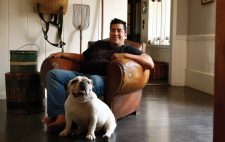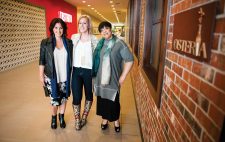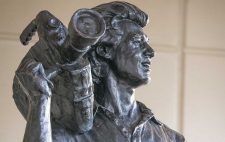Louise Calloway will tell you she’s 84 going on 35. That’s easy to believe, because the petite, soft-spoken woman has an energy that is unstoppable. A lifelong collector of materials from the Underground Railroad, Calloway will use her personal collection to open an Underground Railroad Museum in Smithville.
Who ran the Underground Railroad in South Jersey?
Basically, people who were associated with the religion of Friends, the Quakers, even though some Quakers in Burlington had slaves of their own. These were people who had moral convictions that everybody should be treated equally and shouldn’t have to be in bondage by another human being. There were also free African Americans in the North and some free African Americans in the South who took part in the Underground Railroad. Slaves who worked on the waterfronts would meet free African Americans who were interested in helping and they would tell them where the safe houses were. When the slaves returned to the plantations, they would spread the news. But not all safe houses were safe. Sometimes there would be slave catchers there who took them back into slavery. It was agony to run away, because you didn’t know what you were going to get into.
Many people associate slavery with southern states. Were there many slaves in the North, especially New Jersey?
There were slaves in every state. New Jersey was divided into two parts: east and west. The west was characterized by a Quaker presence who felt they were making slaves moral by enslaving them. But the majority of Quakers were true to their religion and did not have slaves. In the eastern part of New Jersey where there were plantations, slavery was said to be as terrible as it was in Alabama. The slaves were treated very cruelly. In fact, Amendment 13 to the Constitution abolished slavery in 1865, but New Jersey still had 18 people enslaved. New Jersey was really the last state to abolish slavery.
What was the important role Wheatley’s Pharmacy played on the Underground Railroad?
The man who owned the pharmacy was William J. Allinson. He was said to have been a Quaker who believed in the equality of people. Allinson would allow fugitives to remain in his drug store until early in the morning, and then they’d go through the tunnels in the basement of the pharmacy to the Burlington City waterfront. Once at the river they could travel north. The further north they got, the freer they were.
 What sparked your passion for Underground Railroad history?
What sparked your passion for Underground Railroad history?
I had a passion for history in general. When I was about 9 years old I would cut out articles and pictures of African Americans who had contributed a lot to our society and make scrapbooks. There was a Quaker magazine that used to come to our house that celebrated African Americans and would tell about what they were doing in Africa. I became interested in Africa as well as the history of African Americans here.
What is your family’s history during that time?
My family came from North Carolina to North Jersey in about 1900. After the Civil War, they left the South. I don’t know how they did it. A lot stayed because they didn’t have any money to go anywhere else. They built a house. My grandmother took in laundry and my grandfather was a self-made minister. They developed the biggest church in a town called Vauxhall, and they developed the post office. They were the pioneers. In fact, one of the articles about them said they had to walk 15 miles for water when they first settled. They were strong people.
What are some of the highlights of the new museum?
We are going to have two main exhibits about the Underground Railroad. One is going to be a pictorial chronological history. We’ll start from Africa before 1452 and talk about how Pope Nicholas V gave Portugal and Spain the right to go into Africa and take over all the property and make the people perpetual slaves.
We’ll have pictures of the slave ships and trading of slaves, and then we’ll talk about indentured servitude in 1619 and how that eventually resulted in slavery. We’ll have the routes of the Underground Railroad and the stories of 60 abolitionists. There will be a lot about Lincoln, who is very controversial, and the Emancipation Proclamation as a political ploy, the 13th amendment to the Constitution that freed us, and information about the resistance to slavery and slave conspiracies.
The other exhibit will be about African Americans who have contributed to the history of the United States. We’ll have art exhibits every month with receptions for emerging artists, and scholars will speak at least once a month; some will talk about slavery as it’s happening today.
Why was President Lincoln controversial?
He was a great politician and was always against slavery on moral grounds. He didn’t want the Europeans to think we were a country of slavery, but he really didn’t believe that African Americans should be granted the rights of American citizens. At some time he did not want African Americans to remain in America. He developed a commission for African Americans to go to Liberia or Haiti or South America – any place outside the United States. Some people called him an N-lover, so he made a lot of statements to get votes and help people decide that he was not what they said he was. But he did not want us to have the same equality as white people. He said we were inferior and wanted us out of the country.
 Can you talk about an artifact that is especially meaningful to you?
Can you talk about an artifact that is especially meaningful to you?
We will exhibit a sculpture of a maroon, the runaway slaves who went into the swamp lands in Louisiana and the hills of Jamaica. They had their own community, and the sculpture we have is one of the most beautiful I have ever seen. I got it during my travels to Africa. We’ll have a lot of African sculpture in the museum. Another thing that is very important to me is the signatures of Dr. Martin Luther King and a man from Kenya named Tom Mboya, who was like Martin Luther King in his country. They were both in their 30s when they were killed.
How did you get their signatures?
In the ’60s I was at the Atlanta University School of Social Work, and when African dignitaries came to the states they would come to Atlanta. When Tom Mboya visited from Kenya, Martin Luther King and his wife, mother and dad came to welcome him. This was before King became very famous. All of the students were invited to a social for the two men. I was able to talk to both of them, although I don’t remember what we talked about. Martin Luther King was somebody who was easy to talk to; I was in awe of him. It was an amazing time. Martin Luther King’s wife and Tom Mboya’s wife were very good friends. I got the signatures of both men on one sheet of paper.
What do you hope people will learn from the exhibit?
I know people will take away a better understanding of people in general as human beings. There is only one race, the human race, and the thing that divides us is skin color. The validity of that is questionable. Also, they will get an understanding that we’re not the only people who have been abused. A woman from China was talking about how the Chinese were taken over by the Japanese, and Jewish people talk about Germany. We get an idea of how mankind can be very cruel, yet very kind, too.



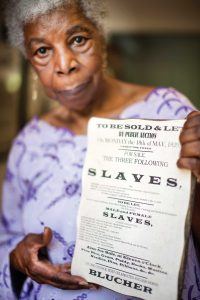 What sparked your passion for Underground Railroad history?
What sparked your passion for Underground Railroad history?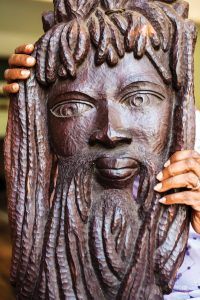 Can you talk about an artifact that is especially meaningful to you?
Can you talk about an artifact that is especially meaningful to you?